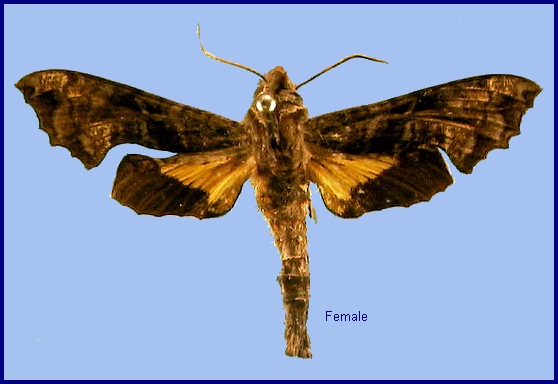
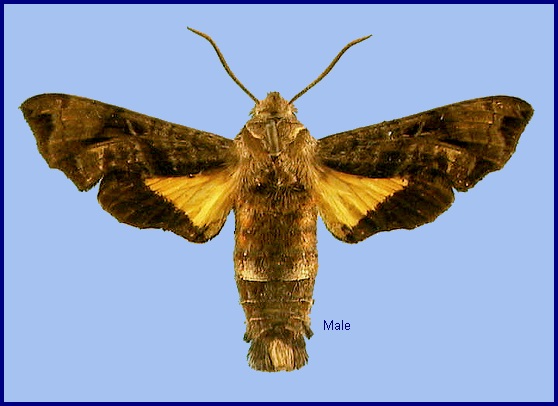
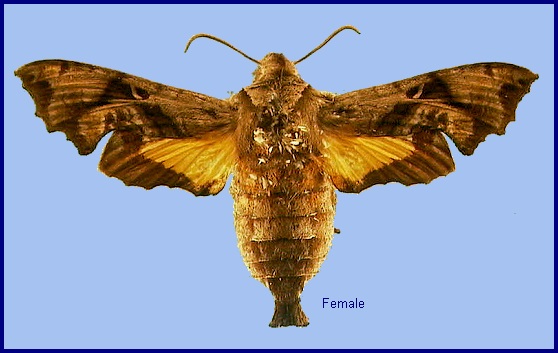
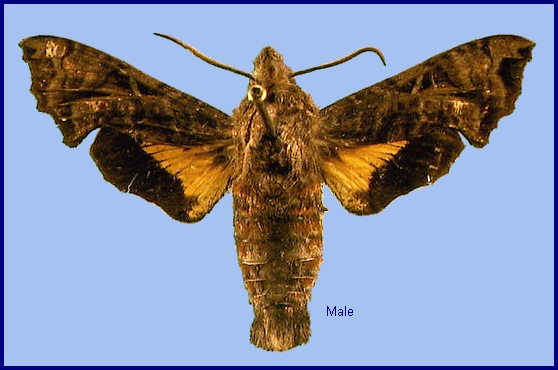
Lophura himachala Butler, [1876], Proc. zool. Soc. Lond. 1875: 621. Type locality: "Northeast Himalayas".
Synonym. Lophura himachala Butler, [1876].
Synonym. Lophura erebina Butler [1876].
Synonym. Lophura sangaica Butler, [1876], Proc. zool. Soc. Lond. 1875: 621. Type locality: [China,] Shanghai.
Synonym. Gurelca himachala purpureosignata Closs, 1917.
Note. Lophura sangaica was synonymized with Gurelca masuriensis as a subspecies by Rothschild & Jordan, 1903, Novit. zool. 9 (suppl.): 589; then with Gurelca himachala as a subspecies by Jordan, 1929, Novit. zool. 35: 87. Treated as a subspecies of Gurelca masuriensis by Bridges, 1993, Cat. Fam. Gen. Spec. Sphingidae of the World: VIII.8. Resynonymized with Neogurelca himachala as a subspecies by Inoue et al., 1996, Moths of Thailand 2: 83. Transferred implicitly to Gurelca by Zhu & Wang, 1997, Fauna Sinica Insecta 11: 320 (key), 321. Implicitly transferred back to Neogurelca as a subspecies of Neogurelca himachala by Kitching & Cadiou, 2000, Hawkmoths of the World: 59. Synonymized with the nominotypical subspecies by Kitching & Rougerie et al., 2018, Biodivers. Data J. 6: e22236. When Rothschild & Jordan (1903) (STI 19807) treated Lophura sangaica as a subspecies of Gurelca masuriensis, they diagnosed it on the basis of a paler forewing upperside and the narrower, more strongly posteriorly tapered dark marginal band of the hindwing upperside. However, Rothschild & Jordan (1903) confounded two taxa in their concept of Gurelca masuriensis masuriensis. Jordan (1929) (STI 18653) separated Gurelca himachala and Gurelca masuriensis, then treating Lophura sangaica as a subspecies of the latter, but without further comment on the diagnostic features of the two subspecies. At that time, Neogurelca himachala himachala was known from NE India and Bhutan, whereas Neogurelca himachala sangaica was known from Eastern China, Taiwan, the Korean Peninsula and Japan. Since then, further collecting has filled the gap in China. Furthermore, examination of the long series of Neogurelca himachala in the NHMUK has shown that the diagnostic characters of Neogurelca himachala sangaica do not hold and that there is no justification for maintaining separate subspecies status for the eastern populations.
[Further details on this species in Japan, as well as photos of many stages, can be found on Digital Moths of Japan as well as Moths of the southern Shikoku, Japan.]
Wingspan: 34--48mm. Darker than Neogurelca masuriensis (Butler, 1875), anal lobe of forewing longer, the hind margin more deeply excised than in that species; black border of hind wing narrower anteriorly and then much more sharply defined than in Neogurelca masuriensis. At rest the adult takes up a somewhat contorted pose.
In the male genitalia, anal tergite less compressed than in Neogurelca masuriensis, sternite broader and more sharply narrowed to a point. Harpe with a basal process which is hollow, open above, the distal part of harpe raised to a sinuate ridge; above this a hairy process on the clasper. Phallus with a long flat process, curving proximad round the sheath and lying flat on it, the proximal edge of this process with vestigial denticulations (Bell & Scott, 1937).
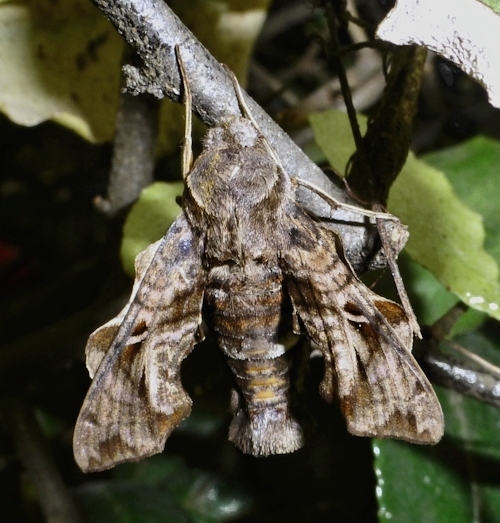
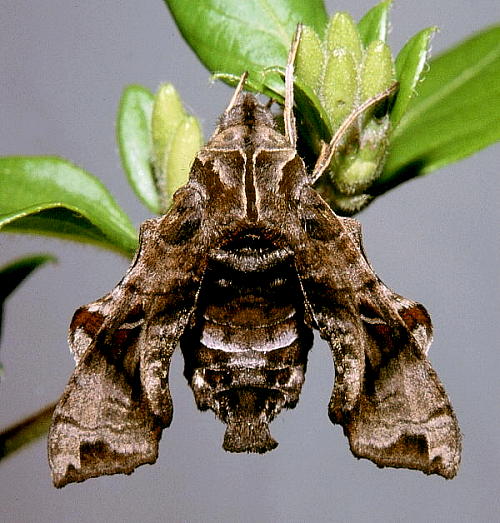
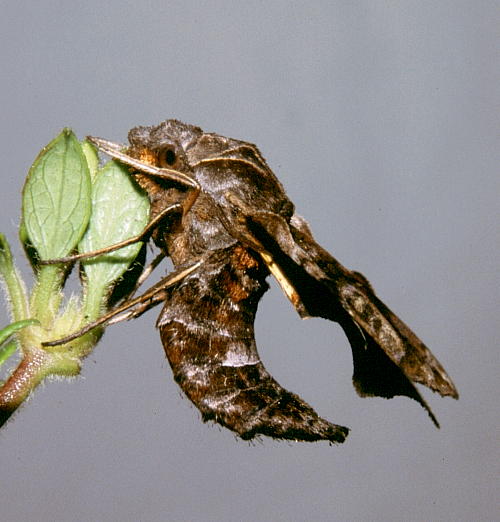
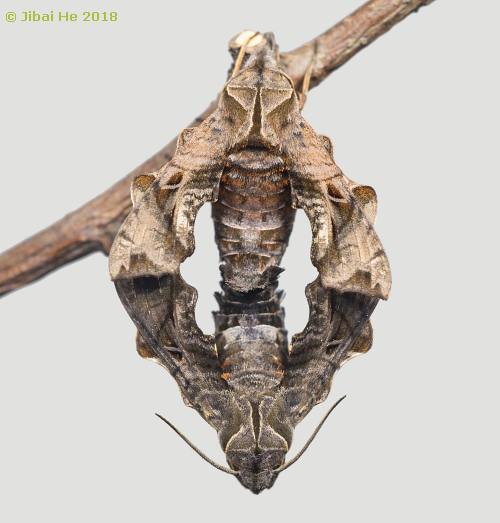
The adults do not fly very much and are active for only a few hours just after day-break and/or at dusk. Females call (scent) in the early morning and may contine to do so for some hours if no male arrives.
A noisy flyer which can manoeuvre with precision in and out of branches and undergrowth, but which will dart off at high speed if disturbed. Rests by day (and night) among dead leaves or on the bark of trees. Great care is taken to make sure that the background matches the colour of the wings -- rough bark is preferred.
Attracted to the flowers of Duranta erecta in Hong Kong.
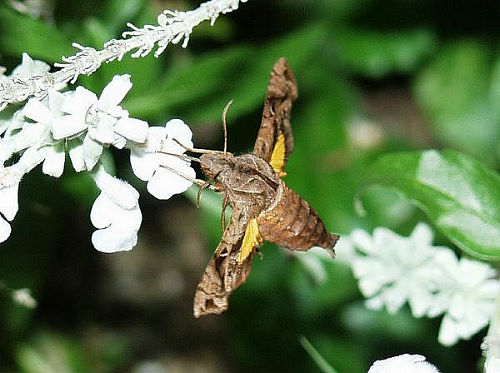
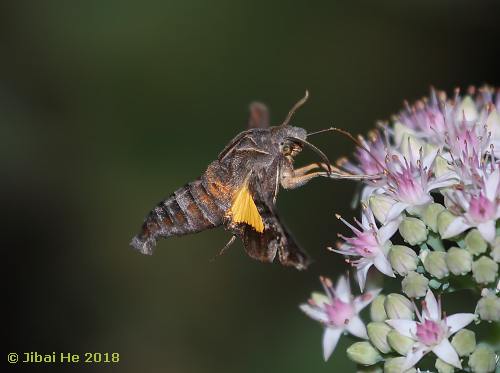
China: i (Zhejiang); 1.iv (Zhejiang); vi (Hubei; Shanghai; Zhejiang); vi-vii (Sichuan; Shaanxi); vii (Jiangxi); viii (Guangdong; Zhejiang); ix (Hong Kong; Zhejiang; Shanghai; Henan); x-xi (Zhejiang; Guangxi; Hubei); 4.xii (Hong Kong). Taiwan: v (Kaohsiung Hsien); vii (Tainan Hsien; Kaohsiung Hsien); ix (Taipei). Japan: 18.iv (Honshu); v-vii (Kyushu); vi-vii (Honshu; Yakushima); viii (Hokkaido); viii-xi (Honshu); 4.x (Shikoku).
In northern China there are two generations per year, with adults flying between June and September (Yang, 1978).
Park et al. (1999) give late June until late September as the flight period in Korea.
OVUM: Pale transluscent white/grey when freshly laid. Small, slightly oval, shiny and smooth.
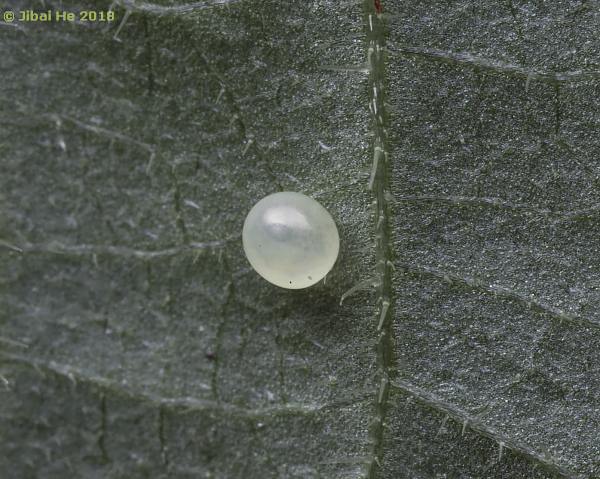
LARVA: Full-fed 42--50mm.; breadth 7mm.; horn 18mm. Polychromatic: Dark brown, grey-brown or yellowish-green with brown markings. According to Bell & Scott (1937), in the final instar head nearly oval and held almost horizontally when at rest. True clypeus narrow, about one-half length of head, basal angles hardly rounded. False clypeus narrow, its apex forming a gothic arch over the apex of true clypeus. Labrum one-half- length of and slightly broader than clypeus. Ligula narrow kidney-shaped. Mandible with the cutting-edge toothed. Eyes with 1 and 2 forming an angle of about 120° with 3, 4 and 6, which are in a straight line; 1, 2 and 3 about one eye-diameter apart, 4 slightly further from 3; 6 two diameters from 4; 5 forming an equilateral triangle with 4 and 6; eye 3 larger than the rest.
Colour of head very variable, green, yellow, grey or brown. A dark brown stripe separating face from cheek. Surface dull and set with short, curved, translucent hairs, each rising from a minute tubercle. Body dull and smooth and cylindrical, but if disturbed the thoracic segments are flared laterally into flanges, similar to those found in Acosmeryx. Horn very long, fairly thick at base, tapering gently to beyond middle and then thickening gently, tip slightly bifid, each arm ending in two points, each of which bears a seta; the basal half of the horn straight and held normally horizontal, the distal half strongly up-curved; surface covered with very regularly placed, small tubercles, each bearing a long and strong seta. This long horn is moved freely in a vertical plane when the larva is walking.
Body equally variable in ground-colour, with the markings fainter or stronger in some forms. In all, a yellow dorso-lateral stripe runs from segment 2 to the base of the horn, this sharply defined above by brown, very narrowly on 2 to 6, more broadly on remaining segments. Segments 2 and 3 suffused with dark brown below the dorso-lateral stripe, and segment 4 with a smaller patch of dark brown not reaching the subdorsal stripe; the hind portion of segment 7 and most of 8 suffused with dark brown below the dorso-lateral stripe and also above it nearly to the dorsum, the stripe represented on 8 by a line of yellow spots. There are whitish oblique stripes in all colour forms, which are sharply defined on segments 5 to 7, missing on 8 and less sharply defined on segments 9 to 11; all stop at the dorso-lateral stripe and are edged above to a greater or lesser extent by dark brown. The dark brown colour may spread on to the dorsum of segments 7 to 11 as a diamond-shaped mark on each segment. Ventral surface mainly brown on abdomen, less so on thorax. Horn smoky-black with black tubercles; legs flesh-colour; prolegs, anal flap and claspers dark brown. Spiracles white with a broad dark brown band across the middle.
Although smaller larvae prefer resting under leaves, larger larvae are to be found on the twining stems of the hostplant, often deep among the foliage. Creepers growing in and on dense shaded shrubs under overhanging trees are preferred during the hot summer months.
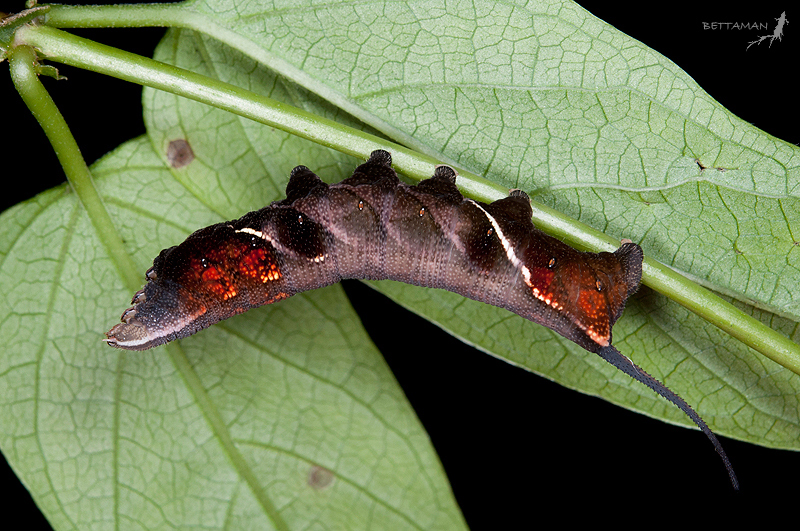
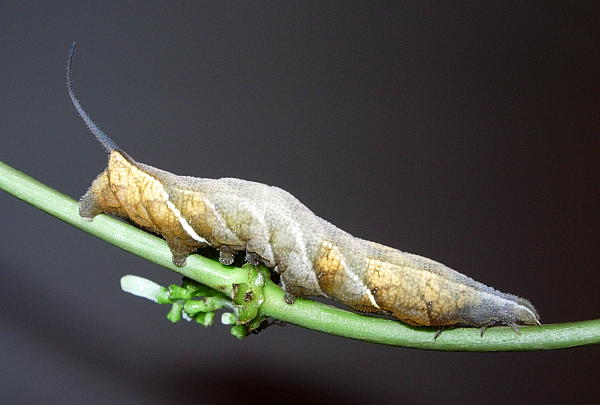
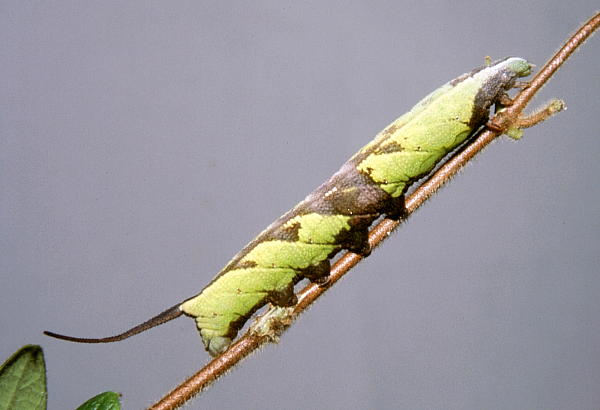
PUPA: 23--25mm.; breadth 8mm. Colour ochreous but transluscent, with the developing adult clearly visible through the cuticle. Head, tongue, wing-case, legs, antenna and thorax with regular interrupted transverse bars of leaden colour, these more prominant dorsally. Intersegmental cuticle of movable segments 8, 9 and 10 deep chestnut. All spiracles and shaft of cremaster dark brown\black, with the spiracles lying on black patches. Stoutish in build, somewhat shiny, and not very mobile. Head elongate but rounded in front; toungue-case not projecting and flush with the surface of the body; shoulders prominent. Antenna shorter than fore leg, and there is a well-developed coxal piece. Head with vertex. Thorax superficially, transversely, irregularly lined. Wing-case smooth, bulging ventrally, thus giving the pupa a 'beer-belly'. Abdomen smooth except for very superficial transverse folds and pits. There are very small erect hairs on the frons and around the spiracles. There is some sculpturing on segment 4 consisting of a small transverse subdorsal weal just behind the front margin, and a small pit above and behind the spiracle of 6. The spiracles of 9, 10 and 11 are situated on the hind face of a ridge running round the front margins of those segments. Segment 9 has small, irregular, ante-spiracular ridges. Spiracle of 2 covered by a rounded lobe projecting from the front margin of 3, its front edge raised. Remaining spiracles broadly oval, edges of central slit raised. Cremaster very short, conical, ending in a short, stout, cylindrical shaft bearing about twelve very short-stemmed anchor-shaped hooklets.
Formed in a folded leaf above or on the ground, this held together by a few thick strands of gummy silk but leaving part of the fold open frontad. As the larva shrinks it often forcibly ejects several jets of excess water through this opening.
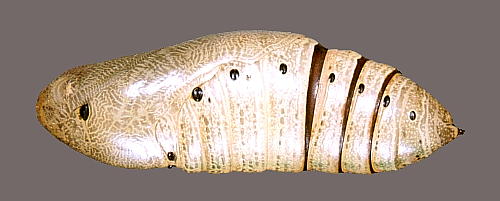
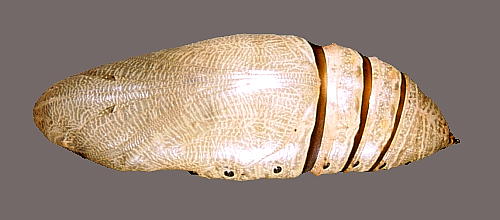
Larval hostplants. As in India, Paederia is utilized in China (Pittaway, pers. obs. 2004), Japan and Taiwan. On the latter island this includes Paederia cavaleriei and Paederia foetida.
[In captivity, larvae will not accept Galium or Cephalanthus occidentalis as substitutes for Paederia. They will reluctantly feed on the former but die some weeks later.]
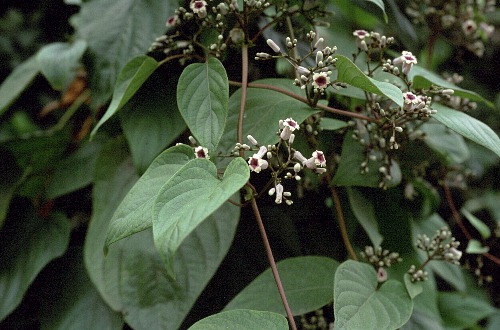
Unknown.
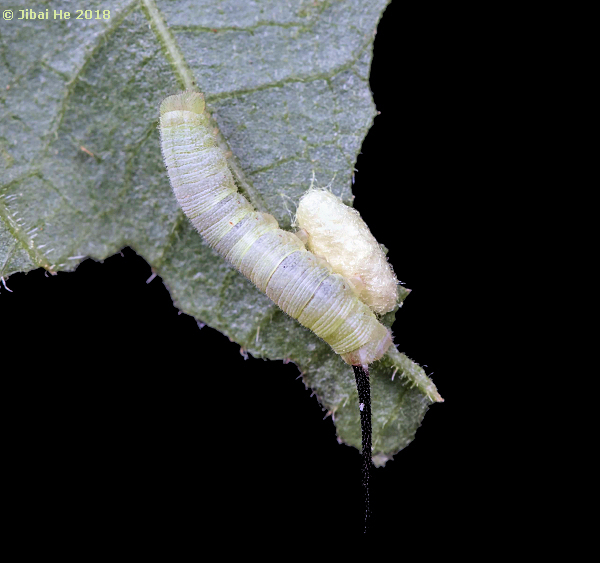
China: Hebei; Beijing; Shaanxi (Niubeiliang Biosphere Reserve, 2802m); Henan (Baotianman National Nature Reserve; Xinyang; Neixiang County); Jiangsu (Nanjing); Shanghai; Zhejiang (Tianmu Shan; Hangzhou; Wanwu); Hubei (Changyang; Wuhan); Hunan (Chenzhou; Yueyang); Jiangxi (Jiujiang); Fujian (Liufang); Sichuan (Baoxing; Kangding; nr. Miannning, 7000'; Emei Shan); Yunnan (Funing; Yanmen; Dali; Molangshan, Yuxi, 1170m); south Xizang/Tibet (Namjagbarwa region, 850-2950m (Wang, 1988); Milin, 2900m; Mainling); Guangdong (E. Nan Ling; Xiaolan; Xiaolou); Hong Kong; Guangxi (Guilin; Liuzhou).
Kendrick (2002) states that this species is only a rare stray in Hong Kong, with only four individuals having been recorded.
[In China, montane populations recorded as Neogurelca himachala should be checked carefully to make sure they are not Neogurelca montana (Rothschild & Jordan, 1915), which has been recorded as far north as Beijing (Xu ZhenBang, pers. comm. 2020).]
Taiwan: Tainan Hsien (Kuantzuling, 1000'); Nantou Hsien (Puli); Kaohsiung Hsien (Shanping, 640m; Liukuei); Taipei (Sindian); Taipei Hsien (Fushan).
North Korea: South Hamgyong Province (Wonsan).
South Korea: Kyonggi Province (Gwangleung); North Chungchong Province (Songni-san); North Cholla Province (Jiri-san); South Cholla Province (Baekyang Temple; Wolchul-san; Seonam Temple; Gwangju); North Kyongsang Province (Andong); South Kyongsang Province (Geoje-do; Namhae; Ulsan; Jinju; Hamyang); Cheju Province (Cheju-do; Halla-san; Youngsil; Ara-dong; Topyung; Seoguipo; Soheung; Isidol).
Japan: Hokkaido (Obirashibe); Honshu (Chiuzenji; Fushiki; Kanazawa; Kawazaki; Kobe; Nagasaki; Niigata; Nikko; Oiwake; Yoshino; Dorokawa; Shimonoseki; Tokei-ji; Tokyo; Yokohama; Nashimoto; Kaibara; Hirakura; Fujimi Heights; Bushi); Shikoku (Matsuyama; Kochi); Kyushu (Kagoshima; Higo Prefecture; Nagasaki; Chiran); Tsushima; Tanegashima; Ryukyu Archipelago (Yakushima).
Nepal, northeastern India (Arunachal Pradesh), northern Thailand, southwestern, central and eastern China (including Xizang/Tibet), Taiwan, North Korea, South Korea and Japan.
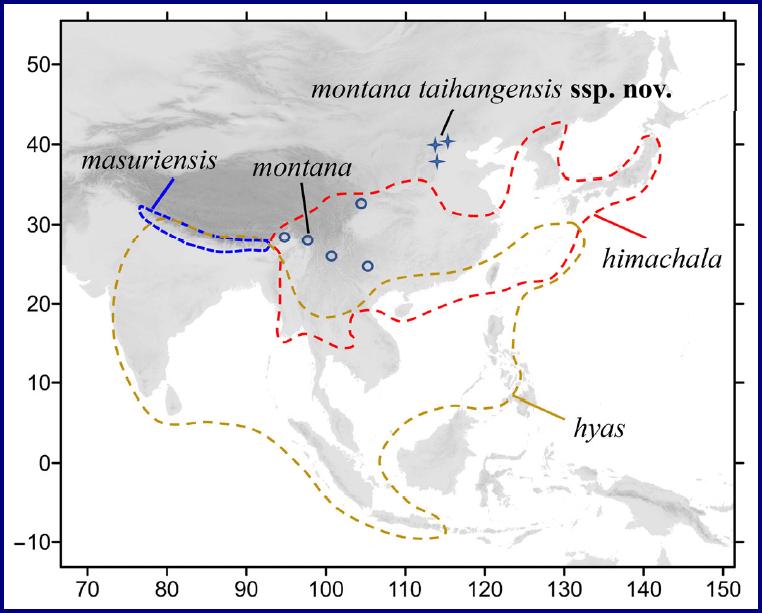
Map: Distribution of species of genus Neogurelca in Asia. The ranges of three species are represented by dashed lines. The blue circles indicate the populations of N. montana montana in Yunnan and Sichuan, the blue stars indicate the populations of N. montana taihangensis in Beijing and Hebei (© Xu, He, Yang, Kitching & Hu, 2023).
 Return to Sphingidae of the Eastern Palaearctic species list
Return to Sphingidae of the Eastern Palaearctic species list